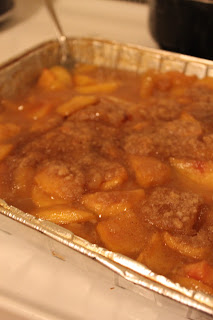Empanadas may not sound like traditional Thanksgiving fare, but they fit right in on tonight’s plate. Apples, raisins, cheese, what’s not to like?
I cheated a bit and bought pre-made frozen empanada wrappers (Goya Discos). They were easy to use and baked up wonderfully – flaky, tender, delicious.
As is always the case with simple recipes, the quality of the ingredients goes a long way. We bought fantastic apples and cheese at Union Square Market – the Newton Pippin apples from Red Jacket Orchards (which my dad called “the best apple he’s ever eaten”) were tart and crisp with a startlingly bright and intense flavor, and the Dorset cheese from Consider Bardwell Farm melted beautifully into the filling, and had a dish-defining but by no means overwhelming funkiness to it. I can’t wait to make these again.
Apple and Cheese Empanadas
¼ cup golden raisins
3 medium tart, crisp apples, such as Newton Pippin or Granny Smith
2 Tablespoons butter
½ cup Calvados
¼ cup grated soft and pungent cheese, such as Dorset, Gruyere, or Raclette
¼ tsp cinnamon
1/8 tsp cumin
¼ tsp kosher salt
6 Goya Discos, or other empanada wrappers
1 egg yolk
Lemon wedges, for serving
1.) Place the raisins in a shallow bowl, cover with Calvados (if ½ cup Calvados does not cover the raisins, add more) and set aside. If you can, do this a few hours in advance to cooking, so the raisins plump up.
2.) Peel, core, and finely dice the apples
3.) Place the butter in a pan over medium-high heat, and let it cook until it has browned (the foam should be uniformly golden brown). Add the apples, stir to combine.
4.) Cook until the apples are soft and nicely browned.
5.) Add the Calvados and raisins. NOTE: THERE MAY BE MASSIVE FLAMES. You are flambe-ing the Calvados, the flames will die down when the alcohol burns off. Just be prepared. Make sure there is nothing flammable above or near the frying pan. If flames don’t erupt when you add the Calvados, induce them by tipping the pan so that the gas flame catches the alcohol, or, if you have an electric range, light the alcohol using a long match.
6.) Once things have calmed down, season to taste with cinnamon, cumin, and salt. The amounts listed above are approximate. You should taste the seasonings, but the apples and raisins should not be overwhelmed.
7.) Scrape the apple mixture into a large bowl, add the cheese and stir to combine.
8.) Preheat the oven to 400°.
9.) Lay out the empanada wrappers and place a heaping tablespoon of the filling in the center of each one.
10.) Fold an empanada in half, cupping it in your left hand. Wet a finger on your right hand and run it along the outer edge of the wrapper. Gently press the two halves of the wrapper together, forming a half-moon shape. Starting at one corner, fold a small section of dough over and gently squeeze it. Fold a second, overlapping crimp, press, then repeat until the entire empanada is sealed.
11.) Poke a few holes in the empanada with the tines of a fork. Whisk the egg yolk, then brush a small amount of yolk onto the top of the empanada (this will give it a nice lustre when you bake it).
12.) Repeat with the remaining empanadas, place on a parchment or wax paper lined cookie sheet and bake 10-15 minutes, until the tops are nicely browned.
13.) Serve with lemon wedges.























